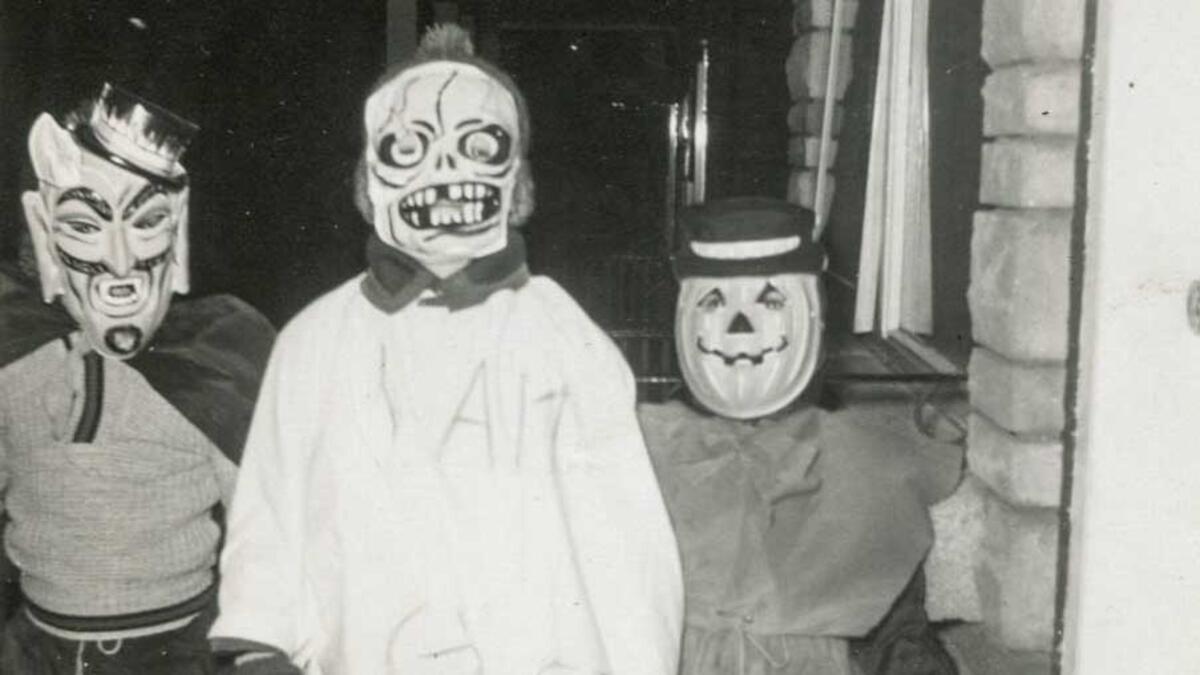GuisingThe practice of disguising oneself, often with a mask, and visiting people's houses.. MummingPantomime acting in a mask for a mummers, or folk, play.. SoulingThe English practice of going from house to house asking for donations of food on All Hallow's Eve.. That which we call Halloween costuming, by any other name would it not still trick-or-treat?
The time-honored tradition of dressing up as vampires and vamps is upon us, prompting reflection on how this practice came to be.
While many of today’s Halloween traditions are closely associated with the United States, a look back at the origins of donning costumes and collecting treats reveals a long and complex evolution that draws from cultural, religious and occult traditions from Europe's Middle Ages that continues to provoke discussion even in modern times.
“Halloween has always been an uneasy fit for some religions,” said Cajsa Baldini, a clinical associate professor of British and European literature and culture in the Department of English at Arizona State University. She adds, “Giant bonfires, demonic faces carved out of produce and general nature worship is difficult to reconcile with some religious beliefs and practices.”
Critics have also clamped down on Halloween for costumes deemed inappropriate and culturally insensitive in recent years. But, as Baldini tells ASU Now, Halloween and the traditions that predate the holiday have always been the subject of scrutiny.
Question: How did the tradition of dressing up for Halloween begin?
Answer: The tradition of Halloween costumes is both ancient and modern. Halloween, as celebrated in the United States today, is largely derived from the Celtic Samhain (pronounced SOW’-en) festival, which celebrated the end of the fertile seasons, and in extension, the end of life. Few artifacts of druid Samhain celebrations have been uncovered, but eyewitness accounts recorded by Roman writers such as Caesar, Suetonius and Diodorus suggest that Samhain celebrations included the lighting of large bonfires to ward off the dark and natural forces emanating from unpopulated wilderness. Druid priests conducting the ceremonies have been depicted wearing long white or gray robes and with oak wreaths on their heads that were likely more in nature with religious vestments than costumes.
With the advent of Christianity, Samhain celebrations soon became absorbed by Christian celebrations such as All Saints’ Day and All Hallows’ Eve, from which the word Halloween is derived. Amalgamated with Samhain are also other, indigenous traditions relating to fall, harvest and also the Mexican feast of Día de los Muertos, and possibly with features of Jewish Purim. What these all have in common is that they address the end of the lighter and fertile part of the year, and a transition into a time of darker and shorter days analogous with the progression of human life.
Cajsa Baldini
Q: Where did the morbidly dark themes of early Halloween costumes stem from?
A: The scary nature of Halloween celebrations today comes out of ancient religious practices, as documented by Roman historians and later Christian writers. While most people no longer think of Halloween as a religious celebration, its historical origins of harvest and fall rites remain, unremembered but embedded — even if we no longer think of this fun tradition as a rite of thankfulness and an effort to appease the forces of death.
It is perhaps this atavistic fear of the forces of death that prompts millions to don vampire and zombie costumes once a year. By disguising ourselves as that which we fear the most, we — in a manner — become one with what we fear, while also disguising ourselves as non-prey. We might think of it as a kind of mimicry of death. Even a costume and mask, which is by definition not scary, is still a disguise in which we take on the look and identity of someone or something else, hoping to cheat those unknown forces that loom larger on these evenings late in October.
Q: How did the tradition of Halloween costuming and trick-or-treating come into being?
A: Combining costuming with trick-or-treating makes the practice even more fun, but is actually a more serious reenactment of sanctioned begging practiced by the poorest of the society at a time of the year when their more fortunate neighbors may have been more inclined to share their bounty. However, as Western society became more secularized in the 19th and 20th centuries, the original purpose of going door to door became further obscuredCiting "Halloween: From Pagan Ritual to Party Night" by Nicholas Rogers (2003).. What did remain as part of the tradition was the spirit of deception and mischief. It became an occasion for engaging with your community by pranking and asking for treats.
Q: When did the Halloween costuming tradition begin in America?
A: Dress-up for Halloween was more or less strictly a U.S. custom from the mid-19th century until just recently, but is now gaining popularity in many parts of the world. While All Hallow’s Eve traditions came to America with Puritan settlers in the 17th century, generally speaking they were not as acceptable as in Britain. Puritan thought inherently distrusted any kind of masking or guising as deceptive and therefore related to Satan, or at the very least reminiscent of Catholicism and its veneration of saints. Halloween, therefore, remained less acceptable well into the 19th century when secularization made it more popular.
It is also possible the large numbers of Irish immigrants coming to the U.S. to escape the great potato famine found Halloween an acceptable compromise between their Catholic celebration of All Saints’ Day and the necessity to integrate in a new country.
Q: How has Halloween evolved from dark traditions to the themes we see in Halloween costumes and practices today?
A: Early Samhain celebrations were said to include sacrifices of harvest products, livestock and possibly also humans. The Roman general Julius Caesar was particularly disturbed by what he described as a “wicker man sacrifice” in his Commentarii de Bello Gallico. We should, however, keep in mind that Caesar’s account of the proceedings could have been motivated by a desire to establish a moral high ground before eradicating the entire priesthood of a conquered people.
It is, however, easy to see how the the menacing atmosphere and horror elements of the original cult have remained a significant aspect of Halloween and to some people’s discomfort. In fact, as late as 2014, conservative media evangelist Pat Robertson declared Halloween to be akin to demon worship and advised parents not to let their children participate.
Halloween traditions today are for most people comfortably nonreligious, but are instead firmly entrenched as a pop-cultural and commercial holiday. Every year we see the zombie-like, seasonal resurrection of the Halloween store across America. An important and engaging feature of modern traditions is that Halloween has become a carnivalesque opportunity for personal imagination and reinvention, whether as a werewolf, a comic book hero, video game character or Alice in Wonderland.
Cajsa Baldini teaches classes in 19th-century fiction that include gothic fantasy tales such as Bram Stoker’s “Dracula” and H.R. Haggard’s “She.” Baldini affectionately calls her lessons “Cult Courses,” attracting a captive audience of upper-division students each semester.
"Cult Courses Promo Video" by Cajsa Baldini
Top photo courtesy Oakenroad via Flickr
MORE HALLOWEEN TREATS
- ASU students tap into fantasy for 'Kiss of the Spider Woman' costumes
- The business of Halloween
- Pop-up stores: Getting into the 'spirit' of Halloween
- How to enjoy Halloween treats responsibly
- Entomology: The real ghouls of nature
- Monster mash-up: English profs fave myths and legends
- Watch: 'Monstrum' host Emily Zarka talks monsters
More Arts, humanities and education

ASU graduate education programs are again ranked among best
Arizona State University’s Mary Lou Fulton College for Teaching and Learning Innovation continues to be one of the best graduate colleges of education in the United States, according to the…
ASU FIDM students to see their designs on the runway at Uncertainty Fashion Showcase
Nola Hill is perfecting every stitch of her fashion design collection, which she started conceptualizing last summer.She is among 30 ASU FIDM fashion design students who have been working late into…

ASU+GSV Summit brings experts together to discuss innovation in education
This week, Arizona State University President Michael Crow and other university leadership joined education and learning experts from around the globe at the ASU+GSV education technology summit in…



